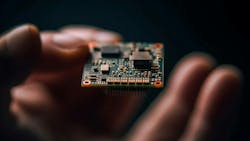Figuring Out the Carbon Footprint of a Chip
Infineon Technologies is breaking down the carbon footprint of electronic devices to the component level, giving engineers the ability to compare its power switches and other product families based on their climate impact.
At PCIM, the annual power electronics trade show, Infineon said it would start sharing what it calls Product Carbon Footprint (PCF) data for its individual products. The company said the new metric would help customers make more sustainability-minded decisions during the design of a product. But without any industry-standard way for other companies to calculate the carbon footprint of their chips, comparing products from different vendors isn’t in the cards yet.
For Infineon, a chip’s carbon footprint spans the whole supply chain that produced it, from mining the precious metals and sourcing the other raw materials used to fabricate them, to shipping the finished product to electronics companies and other customers. The PCF metric is a snapshot of all carbon and other greenhouse gas emissions generated from one end of the process to the other. It’s measured in equivalent kilograms of carbon dioxide (kg CO2e).
Every component in every electronic device has its own carbon footprint. But breaking down the carbon impact at the chip level turns out to be critical. As researchers at Harvard University figured out in a 2020 paper “most of the carbon output” from the average electronic device stems from manufacturing the chips inside instead of the electricity it consumes during use or what happens to it at the end of its life.
Elke Reichart, Infineon’s chief sustainability officer, said the component-level data is “empowering our customers to reduce carbon emissions even more effectively” along the entire supply chain.
According to Infineon, it’s calculating the carbon footprints of only about half its product portfolio at this point—everything from its families of silicon (Si), silicon carbide (SiC), and gallium nitride (GaN) power switching technologies to its automotive-grade microcontrollers (MCUs). But executives plan to eventually share data for Infineon’s full product portfolio. The entire list of reference product families is here.
Understanding the Carbon Impact of Chip Manufacturing
The semiconductor industry has been trying to grapple with its huge carbon footprint in recent years.
Today, chip firms use vast amounts of electricity to mass-produce the chips at the heart of everything from fighter jets to automobiles to smartphones. They also use large quantities of chemicals, gases, and other raw materials to run the state-of-the-art equipment in their fabs. But nothing contributes more to a chip’s carbon footprint than the electricity used to fabricate it, which in many cases is not generated by renewables.
More than 80% of the industry’s carbon emissions stem from the use of electricity, typically generated by third parties and primarily used for manufacturing, according to a report by Boston Consulting Group and SEMI, a trade group for the electronics manufacturing and design supply chain.
Chipmaking is one of the most complicated and costly endeavors in the world of manufacturing. Before the chip itself is manufactured, silicon wafers are formed by melting down raw silicon, refining it, and shaping it into cylindrical rods of silicon. Huge furnaces are used in this process, and they can run at up to several thousand degrees and thus are very power-hungry. These rods of purified silicon must be then sliced into thin discs and polished to remove as many irregularities and impurities as possible before being shipped out to fabs that turn them into chips.
Inside the fab, it can take several months for the silicon wafer to run through the hundreds or thousands of process steps required to process and package them into a finished product. The wafers go through rows of high-end machines that very accurately deposit microscopic materials on the surface, scorch transistor patterns into the silicon, and etch away the unnecessary portions—all of which use considerable power. Filtering dust out of the air and regulating the temperature and humidity in a fab’s cleanroom also consume electricity.
Furthermore, modern fabs use a wide range of process gases to clean the surface of the silicon wafers and others that intricately etch the transistors on these shimmering discs of silicon. Other gases are used to clean the delicate insides of the state-of-the-art manufacturing tools in a fab, where the wafer can sit for hours at a time to alter the characteristics of the underlying silicon or reshape the transistors placed on top of them.
While many new fabs have “abatement” systems that can burn most of these gases into harmless components, the gases can escape into the atmosphere, where they act as potent greenhouse gases. Sulfur hexafluoride (SF6), widely used in the etching process, is one of the most destructive. It is 23,500X more effective at trapping heat than CO2, which means that even a small amount leaking out of the fab can have a severe impact on climate change.
A wide range of hazardous chemicals that can also have large carbon footprints are vital to modern chipmaking. Rinsing off chips with huge amounts of ultra-pure water is another common step in the production process.
Under pressure from electronics makers and other customers seeking to advance their own sustainability goals, Infineon and other big names in the semiconductor business are taking steps to turn things around.
Infineon has pledged to become carbon neutral for its direct (Scope 1) and indirect (Scope 2) emissions by 2030. The plan is to use renewables for more of its electricity and reduce how much is consumed by its fabs and other operations in the first place. It’s also investing in new technologies to prevent gases from escaping its fabs as exhaust. To account for any remaining “unavoidable” emissions, it plans to purchase green electricity.
The company has also committed to setting goals regarding the carbon emissions from its supply chain (Scope 3). The challenge here is bringing everyone from semiconductor equipment vendors to material suppliers in line. On top of that, Infineon is investing in a wide range of new technologies focused on sustainability, such as circuit boards that can be recycled at the end of their lives instead of being discarded or incinerated.
Infineon's "Cradle to Gate" Carbon-Emission Calculation Method
In the absence of any established industry standards, Infineon developed a method to calculate the carbon emissions of its chips and other products by tracking them as closely as possible from the “cradle to gate.”
The PCF covers all the carbon emissions associated with the design and manufacturing processes for its products—also called Scope 1—along with any other greenhouse gases—Scope 2—stemming from purchasing electricity used by its fabs and the sourcing of chemicals, gases, and other raw materials. The new metric factors in everything down to the transportation of the final chip to a customer’s front gate.
In addition, the metric covers Scope 3 emissions stemming from its suppliers and other manufacturing partners that inevitably expel carbon while sourcing raw materials and manufacturing. Though it’s capturing all carbon emissions that it’s responsible for—directly or indirectly—Infineon isn’t factoring in the carbon output from customer operations or the use of those products by consumers that are out of its hands.
For instance, Infineon said the SiC power MOSFETs in its CoolSiC family account for carbon emissions equal to 87.5 g of CO2, while the silicon power MOSFETs in its latest automotive-grade OptiMOS family is rated for 3.5 g of CO2. While SiC power switches are a special case, most of its analog and power chips use "legacy” process technologies that are less power-hungry overall. The company said its more advanced automotive MCUs account for more than 400 g of CO2e by the time they’re shipped to customers.
The rule of thumb in the chip business is that the smaller the process node—as small as 3 nm in the most advanced systems-on-chip (SoCs)—the more electricity is consumed for each square millimeter of silicon.
Infineon said a growing number of electronics makers and other customers want to increase transparency regarding the carbon footprint of their products, so they’re keen to get more data on specific components.
The semiconductor industry has its work cut out when it comes to sustainability. But Infineon pointed out that its power semiconductors and other chips have a hand in combating climate change more broadly.
According to Infineon, these chips are integral to everything from electric vehicles (EVs) to solar, wind, and other sources of renewable energy. They’re also vital to increasing energy efficiency in data centers that are devouring more and more power to run large language models (LLMs) and other types of AI. The company said that its chips save 34X the amount of CO2e released during their production over their lifecycle.
Check out more of our PCIM 2024 coverage. Also, read more articles in the TechXchange: Sustainable Electronics.
About the Author
James Morra
Senior Editor
James Morra is the senior editor for Electronic Design, covering the semiconductor industry and new technology trends, with a focus on power electronics and power management. He also reports on the business behind electrical engineering, including the electronics supply chain. He joined Electronic Design in 2015 and is based in Chicago, Illinois.



